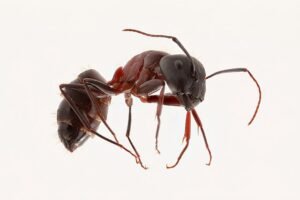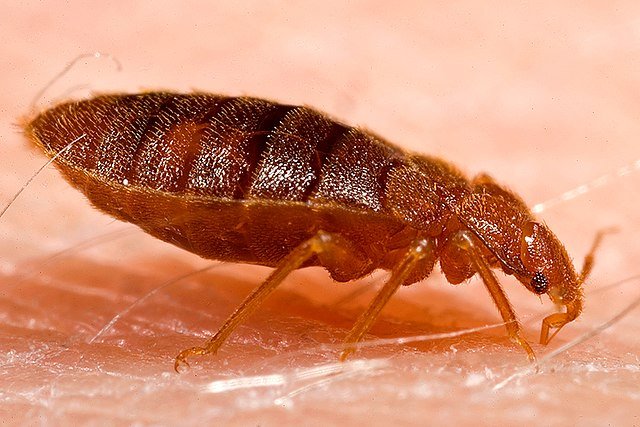Carpenter Ants: Identification, Biology, Risks, and Control
 The carpenter ant (Camponotus spp.) is one of the largest and most destructive structural ants in the world. Unlike invasive ants such as the Argentine ant (Linepithema humile) or aggressive species like the red imported fire ant (Solenopsis invicta), carpenter ants do not sting and rarely bite humans. Their threat comes from their ability to excavate wood and compromise buildings.
The carpenter ant (Camponotus spp.) is one of the largest and most destructive structural ants in the world. Unlike invasive ants such as the Argentine ant (Linepithema humile) or aggressive species like the red imported fire ant (Solenopsis invicta), carpenter ants do not sting and rarely bite humans. Their threat comes from their ability to excavate wood and compromise buildings.
These ants are not true wood-eaters like termites, but their nesting habits inside wood create tunnels and galleries that weaken structures. Because infestations often remain hidden for years, carpenter ants are considered a silent but costly pest.
Identification
Carpenter ants can be identified by several distinct traits, but confusion with other large ant species is common.
Size: Workers range from 6–13 mm, with major workers (soldiers) larger than minor workers.
Color: Species vary in color from black (Camponotus pennsylvanicus) to red-and-black combinations (Camponotus floridanus).
Shape: Smooth, evenly rounded thorax when viewed from the side.
Antennae: Elbowed, 12 segments, no club.
Wings (reproductives): Swarming ants appear in spring, with long transparent wings.
Frass: Piles of wood shavings and debris outside nest entrances, often mistaken for sawdust.
Carpenter ants are nocturnal foragers, often seen trailing along foundations, walls, or tree branches.
Biology and Ecology
Nesting behavior
Colonies have a primary nest (usually outdoors in live or dead wood) and satellite nests inside buildings.
Primary nest houses the queen and brood. Satellite nests store workers and sometimes pupae.
Colonies may take 3–5 years to mature and can exceed 20,000 workers.
Diet
Unlike termites, carpenter ants do not eat wood.
They feed on honeydew from aphids and scale insects, plant juices, and household foods like sweets, meats, and fats.
Inside homes, they are attracted to sugary drinks, pet food, and kitchen scraps.
Reproduction
Winged reproductives swarm in spring and early summer.
After mating, queens shed wings and start new nests in moist or decayed wood.
Ecology
Carpenter ants play a role in forest ecosystems by breaking down dead trees and recycling nutrients. However, their behavior becomes destructive when they move into man-made structures.
Global Distribution
Camponotus spp. occur worldwide, with hundreds of species adapted to different climates.
North America: C. pennsylvanicus in eastern forests, C. modoc in western regions, C. floridanus in the Southeast.
Europe: Several species including C. ligniperda and C. herculeanus, found in forests and urban areas.
Asia: Large diversity across temperate and tropical regions.
Australia: Native carpenter ant species are widespread.
They thrive in moist climates with abundant wood, but satellite nests in dry areas allow them to expand into urban landscapes.
Risks and Damage
Structural damage
Excavation of wood weakens beams, floors, and roofs.
Colonies often target moist or previously damaged wood.
Repairs can cost thousands of dollars if infestations go undetected.
Agricultural and garden impact
Protect honeydew-producing insects like aphids and mealybugs, leading to outbreaks on fruit trees and ornamentals.
Nesting in tree trunks may cause dieback or breakage.
Nuisance factor
Foraging workers invade kitchens and pantries.
Nocturnal activity may disturb residents.
Presence of winged reproductives indoors is alarming for homeowners.
Signs of Infestation
Frass piles: Sawdust-like debris with insect parts near wood structures.
Rustling sounds: Ants moving inside walls or hollow wood.
Moisture association: Infestations often near leaky pipes, roofs, or window frames.
Swarmers indoors: Winged ants emerging inside during spring.
Foraging trails: Workers visible at night along baseboards, sinks, or exterior walls.
Control Methods
Chemical methods
Baits: Protein and sugar-based baits with slow-acting toxicants (fipronil, hydramethylnon, indoxacarb).
Dust insecticides: Applied inside wall voids and galleries.
Residual sprays: Used along trails and entry points, but less effective alone.
Non-chemical practices
Eliminate moisture by fixing leaks and improving ventilation.
Remove decayed wood and firewood stored near buildings.
Trim branches that touch roofs and walls to reduce ant access.
Professional strategies
Locating and treating both primary and satellite nests.
Use of boric acid dusts in inaccessible areas.
Regular inspections to prevent reinfestation.
Advanced Approaches
Infrared detection: Thermal cameras locate nests inside walls by spotting heat generated by colonies.
Moisture control systems: Long-term prevention through building maintenance.
IGRs (Insect Growth Regulators): Disrupt colony development, reducing reproductive success.
Integrated pest management (IPM): Combines inspection, exclusion, baiting, and monitoring.
Research continues into microbial pathogens and natural predators, though practical application remains limited.
Cultural and Historical Context
Carpenter ants have been recognized for centuries as wood destroyers.
In Europe, old homes built with untreated timber often carried infestations of Camponotus ligniperda.
In North America, carpenter ants became a focus of pest control research in the 20th century, as suburban housing with wooden frames expanded.
Folklore in rural communities often blurred distinctions between termites and carpenter ants, with both seen as “house-eating ants.”
Today, carpenter ants remain one of the most cited reasons for pest control calls in temperate regions, alongside termites and bed bugs (Cimex lectularius).
FAQ Section
Q1: Do carpenter ants eat wood like termites?
No. They excavate wood to create nests but feed on sugars and proteins.
Q2: Are carpenter ant bites dangerous?
Bites are rare and usually harmless, though they may spray formic acid, causing minor irritation.
Q3: How can you tell the difference between carpenter ants and termites?
Carpenter ants have elbowed antennae, narrow waists, and dark bodies, while termites have straight antennae, broad waists, and lighter coloration.
Q4: Can carpenter ants destroy a house?
Yes, long-term infestations can cause severe structural weakening, though usually slower than termites.
Q5: What is the best bait for carpenter ants?
Carbohydrate baits work when colonies seek sugar, while protein-based baits are effective during brood-rearing phases.
Q6: Why do carpenter ants appear in kitchens?
They are searching for sweets, proteins, or fats, often near sinks, dishwashers, and food storage.
Q7: Do carpenter ants prefer wet wood?
Yes. Moist, decayed wood is easier to excavate, though colonies may expand into dry wood over time.
Q8: How do carpenter ants spread?
Through mating flights in spring or by establishing satellite nests connected to a primary colony.
Final Thoughts
The carpenter ant (Camponotus spp.) is one of the most significant structural pests worldwide. Unlike termites, they do not consume wood, but their excavation weakens beams, flooring, and even entire roof structures. Because infestations often go unnoticed until damage is extensive, carpenter ants represent both an economic and safety concern for homeowners.
Prevention is always more cost-effective than repair. Eliminating moisture problems, sealing entry points, and reducing wood-to-soil contact can greatly reduce the risk of infestation. For established colonies, integrated pest management (IPM)—combining moisture control, targeted baiting, dusts, and professional inspections—offers the best results.
As climate patterns shift and wooden structures remain central to construction, carpenter ants will continue to be a widespread challenge. The key is awareness, early detection, and consistent professional management to protect homes and businesses.
Disclaimer
This article is for informational purposes only. Pest control laws and approved chemicals vary by country. For best results and legal safety, we strongly recommend contacting a licensed pest control professional in your local area. Always make sure that the pest control technician is properly certified or licensed, depending on your country’s regulations. It’s important to confirm that they only use approved products and apply them exactly as instructed on the product label. In most places in Europe, UK, or USA, following label directions is not just best practice—it’s the law.
Author Bio
Nasos Iliopoulos
BSc Agronomist & Certified Pest Control Expert
Scientific Director – Advance Services (Athens, Greece)
Licensed Pest Control Business – Ministry of Rural Development & Food (GR)
References
Wikipedia, Carpenter Ants
Britannica, Carpenter Ants

